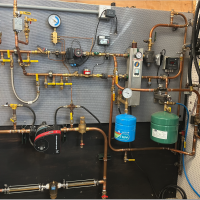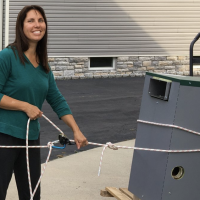Best Of
Re: Air Scoop or Air Eliminator?
True story: There was a Post Office in Dennis Twp., NJ that was connected to the home that the post master lived in. The CH boiler was located in the basement and there were at least 5 different zones operated by zone valves and one circulator pump located on the boiler return. The expansion device was the older 30 gallon compression tank strapped between the ceiling joists in the basement above the boiler.
For the 14 years that I did the annual maintenance on that home, (and for years before they were my customer) the expansion tank would need to be drained at least 2 times per year. The Post Master/Homeowner would need to let air out of the radiators on a regular basis, and I would need to come and purge the baseboard loop zones at least once a year. It was just the way this system worked and the guys that worked for me knew that this was just the way it was.
At one point the boiler started leaking (Go figure with always adding fresh water over the years). and U had just finished a Dan Holahan Class on Hydronics. My company was awarded the contract to replace the boiler and I gave specific instructions on where the new Extrol 30 tank was to be installed on the supply pipe out of the boiler. I spent a crazy high price for one of those new Spirovent things that has just come on the scene. And I wanted the circulator to pump away from the expansion tank. My seasoned boiler installer thought I was crazy.
When the boiler was finished, and filled with water, it was about 4:30 in the afternoon on the second day of the job and my installer started to pack up to return tomorrow to do the purging and venting of air that was sure to be another 1/2 day based on our experience with this job. I said Hold On. Purge the loops while I do the cast iron zone with my radiator key, these folks are getting heat tonight. Within 30 minutes the boiler was ready to fire up and my boiler installer was amazed that the water circulated on each zone and the Spirovent was dumping excess air from the zones until each loop returned Hot back at the return. This Known "Air Problem" system is now a system that automatically removes air from the radiators while operating. You just need the let the science work for you … NOT against you!
Re: Taco 007 Circulator Replacement Sizing? Undersized even though working ok?
I guess the best proof of concept is that the current 007 gets the job done
If anything I would use a pump that adjusts to the required output of the 3 zones as the toggle in and out, a delta P circ pretty much flattens the curve across the operating conditions. It also consumes less power doing so
 hot_rod
hot_rod
Re: Air Scoop or Air Eliminator?
as the name implies air seps gets the microbubbles out, usually within a few passes
The Discal has a large chamber for a low velocity zone, and a large non metallic media
It can be disassembled at top, usually by hand, to clean or replace the float and needle valve
Micro bubbles form when heat is applied to metal, go put a pan on your stove, a cup of water in it, turn on the burner. What do you see happening at the bottom of the pan after a few seconds?
In a closed loop system those bubbles need to be moved out, or they go back into solution when the water cools, snd the cycle repeats.
Ramp type purgers struggle to get those tiny bubbles
So heat transfer in the boiler and in the heat emitter suffer with bubbles instead if water in contact we the metal
A camel hump purger is really not much more than a coupling
Do a search and see how many air issues come across this site.
 hot_rod
hot_rod
Re: New Century House with Two Pipe Steam - Questions
one easy way I have found to “test” steam traps is to remove the cap and see if the radiator behaves differently. Traps fail open or closed. If the trap fails closed, air cannot vent and steam cannot enter. Removing the cap will let you determine if the problem is the trap or something else downstream.
Even replacing the guts is expensive. I replaced 17 innards ~15 years ago on a then 85 year old system but threw them all in a box and kept them. I recently plumbed a takeoff on my main with a valve where I could install a trap and test it. 16 of the 17 elements that I replaced 15 years ago are good. Now they are spares.
IMO, it is great to spend money where you need but not indiscriminately.
One place I spent was the low pressure gauge. Impressive seeing these things run on a couple of inches of water pressure.
Obviously, be careful with the steam but you will feel the radiator getting warm and hear and see the condensate long before the steam becomes dangerous.
If the trap has failed open and the radiator doesn’t heat, the problem lies elsewhere. If the down stream side of the trap is steam hot it has failed open, or some other part of the system is back feeding steam on the return side.
Re: Savings ???? Repipe
Yes the temperature of steam will go up with the pressure, but not nearly enough to absorb all the output of a boiler. And you keep saying "goes up the vent" but I can't for the life of me understand what you mean there. I thought it was a typo the first time but apparently not 🙂
The problem you have with that argument is that there are numerous examples of steam boilers that get repiped properly and cut their fuel consumption by 20%.
I would truly like to see evidence of that because honestly I just can't understand where that 20% went before and no one here seems to want to tell me, but they sure like to tell me how wrong I am 😅
you'll have to agree that all the garbage NBP that we see on here doesn't matter.
Indeed it often doesn't. I'll talk about it in the video. Probably won't be until next week though.
Re: Air to Water Heat Pumps
To be clear, I'm not opposed to air handlers. I'm a big fan of small ones in the 3000-10,000 BTU/hr range, with variable speed fans. Put one of those in each room with an independent thermostat and you get unsurpassed comfort, incredible temperature stability. They're a good complement to under-floor heat because they're able to ramp up and down much more quickly, and of course in the summer they provide cooling. And the BOM isn't too awful, you might be able to get away for less than $1000 per room which is pretty good when you're looking at each room having its own thermostat. That's what I have in my own home*.
The issue I have is with big three-ton air handlers with ductwork. They get installed just like conventional AC and they offer no benefits. But since everything in the hydronics world is niche, they end up costing two to three times as much as conventional AC. And this gets to a general theme in my thinking when it comes to air-to-water, which is that the question is never whether something is possible, it's whether it's practical. Ideas that drive up the cost of installation without delivering value just aren't practical.
*(I will say that I am disappointed with the product offerings available in the US right now when it comes to small air handlers. I have seven air handlers in my house, a couple of them I imported direct from overseas and all of them had to be modified and customized extensively to make them work satisfactorily. Nothing wrong with the technology, just the implementation. I couldn't in good faith recommend any of them as they come out of the box.)
Re: Air to Water Heat Pumps
I love Seigenthaler, I've learned a lot from his writings and I consider him influential in my learning. However, having seen a few videos and read a few articles by him on air-to-water, I have to disagree with some of his design choices.
First, he often includes DHW and a backup boiler in his designs, as I noted above I believe that's just a bad idea.
When it comes to cooling, he often advocates installing a three-ton air handler with ductwork and a hydronic cooling coil. That's basically giving away all the advantages of hydronics. You're left with no advantage over conventional AC and a bill of materials that's two to three times as high.
He often says, "with the right controls, hydronic panels can be used for cooling." I feel this is a dangerous over-simplification.
I don't know if he's still advocating this, but in the past I've seen designs from him where he puts the temperature sensor in the buffer tank. One of the keys to understanding air-to-water is that the heat pump wants to adjust its output to meet the load, and you want to do as little as possible to obscure from the heat pump what the load is. This sensor placement has the effect of obscuring from the actual load, and can lead to unnecessary short cycling.
We're all still learning.
Re: Maid-O-Mist Failure Rate ?
To All, I have tested well over 200 vents from various manufacturers. Mainly the most popular ones. I have purchased them from various vendors. I have many years of experience in test and measurement and design for electronic and mechanical components mostly in the defense industry. There is clearly something wrong with the quality of vents produced in the steam heating industry. I am not referring to failures due to misuse such as high pressure or foreign material. The level of failure that I have noticed is not tolerated in other industries. As my engineering manager told me in 1988, when I asked him how come his prototypes are always close to prediction: Any one can come up with a design, you have to know how to build it and how to test it. Vents are not difficult to produce if you know what you are doing. It is not rocket science. [My last employer was Northrop Grumman]
Flex Joint?
Has anyone used a flex joint to isolate boiler vibration from the mains and returns? Something like this:
Re: Buderus gb142-24 boiler temp issue
The AM10 is regulating the boiler water temperature. If it’s heating the house sufficiently, then it’s doing its job and should be left alone.
 Ironman
Ironman




